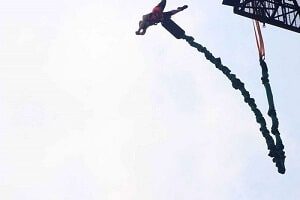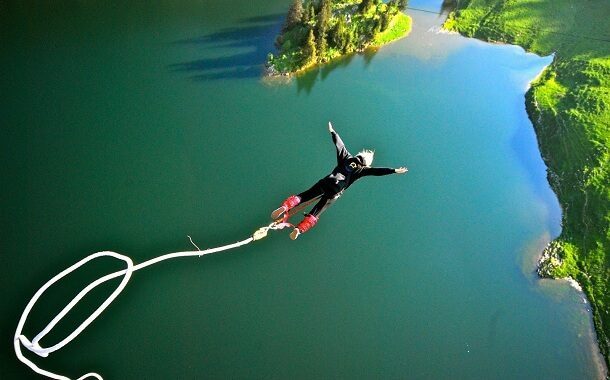How Much Does Bungee Jumping Cost?
Last Updated on January 26, 2024
Written by CPA Alec Pow | Content Reviewed by ![]() CFA Alexander Popinker
CFA Alexander Popinker
Bungee jumping is an incredible adrenaline-pumping experience that many adventure and thrill seekers have on their bucket list. But between equipment, location, and overall experience, bungee jumping costs can quickly add up.
This guide will provide important insight into average bungee jumping prices worldwide, factors affecting costs, location comparisons, safety considerations, discounts, and tips for first-timers to make your thrilling jump more affordable.
How Much Does Bungee Jumping Cost?
Globally, bungee jumping prices typically range from $70 to $300 per jump, with an average cost of $150. However, prices can fluctuate significantly depending on your location.
In the United States, average bungee jumping costs are around $100 to $200. Popular spots like the Bungee America in California charge around $169 per jump.
In Canada, prices are comparable to the US, ranging from $100 to $250. At Great Canadian Bungee near Vancouver, tandem jumps start at $169.
Europe offers some of the world’s most iconic bungee jumping locations but at premium rates. In Switzerland, jumps from the Verzasca Dam start at around $255. At Croatia’s picturesque Mostar Bridge, single jumps are $150.
New Zealand is considered the birthplace of bungee jumping, with some of the highest jumps off platforms like the Nevis Bungy. Prices here run $180 to $260.
In Australia, bungee prices typically start around $120, like at the AJ Hackett Cairns jump. At adrenaline hotspots like Queenstown, New Zealand, jumps can reach $200 to $280.
In Asia, prices are often lower than in the West. In China, jumps off Macau Tower start around $150. At Nepal’s Last Resort, twin jumps are $100. In Thailand, jumps are as low as $70.
According to Exploration Junkie, the cost of bungee jumping can range from $30 to $500, depending on the location and the height of the structure. For example, in the USA, New Zealand, and Italy, it’s usually over $100, while in South Africa, it’s about $40, and in Goa, it’s about $50. Additionally, helicopter bungee jumping is mentioned to be expensive, costing up to $1,000.
Bungee America mentions that weekday/midweek jumps require a minimum of $1,000 in jumps, which can be any combination of jumpers and jump packages.
Bungee.com provides specific prices for bungee jumping, such as $99 for one jump or $129 for one person to jump twice. It also mentions helicopter bungee jumping and jumping out of a helicopter over a volcano.
Cost Breakdown: Equipment, Location, and Experience
The total bungee jumping cost consists of these key components:
Bungee Equipment
- Harness rental – $25-$60
- Ankle ties – $10-$30
- Helmet – Optional $5-$15
Location
- Bridge/crane platform – More complex setups like bridges cost more than crane platforms.
- Jump height – The higher the jump, the higher the cost. Jumps over 100m start around $150.
- Insurance – More complex locations mean higher insurance fees.
- Staffing – More staff needed equals higher cost.
Experience
- Photos/videos – $40-$100 for media package
- T-shirt – $15-$30 for branded merch
- Certificate – $10-$20 for proof of the jump
So while the jump itself may only cost $100, extras like photos, merchandise, insurance, and equipment rentals can quickly add $50-$150+ more.
What is Bungee Jumping?
Bungee jumping involves leaping from a tall structure while connected to an elastic cord that stops your descent right before hitting the ground. The thrilling freefall followed by the rebound creates an incredible adrenaline rush.
While commercial bungee jumping is relatively modern, origins can be traced back centuries to the “land diving” ritual on the island of Pentecost in Vanuatu. The first modern bungee jumps were performed in Bristol in 1979 from the Clifton Suspension Bridge. By the 1980s, AJ Hackett brought bungee jumping into the mainstream with jumps from the Eiffel Tower.
Today, bungee jumping hotspots include bridges, cranes, hot air balloons, and skyscraper observation decks across the world. Jumps typically range from 100-760 feet, with bungee cords creating a rebound effect 2-3 times the jump height. Proper harnessing and cord elasticity prevent injury.
Factors Influencing the Cost of Bungee Jumping
Several important factors play into bungee jumping prices, including:
- Location – More complex setups like bridges cost more than cranes. Iconic spots charge premium rates.
- Height – The highest jumps from 300ft+ range from $200-$300. Lower 100ft jumps can be under $100.
- Type of Jump – Tandem and group jumps usually cost more than solo. Night jumps also add a premium.
- Add-Ons – Photos, video, merchandise, and certifications all increase price.
- Insurance – Jumping at riskier locations leads operators to carry more insurance.
- Operator Reputation – Well-known operators can charge more than independent setups.
Comparing Bungee Jumping Costs at Different Locations
Bungee jumping from bridges, hot air balloons, cranes, and skyscrapers provides distinctly different experiences at varying price points.
Bridges: Iconic jumps from bridges like New Zealand’s Kawarau Gorge Bridge cost $200-$260. The setup required for bridges boosts prices.
Cranes: Jumps from fixed cranes like Greece’s Corinth Canal with an elevator going up to the crane run $140-$180 per person. Minimal setup leads to better value.
You might also like our articles about the cost of iFly, skydiving, or wingsuits.
Hot Air Balloons: Floating balloon jumps like Florida’s Orlando Balloon Jump start around $170. Unique aerial views come at a premium.
Skyscrapers: Jumps from towers like Macau Tower in China run $150-200. Higher insurance costs add to skyscraper jump prices.
So while bridges provide a thrilling backdrop, crane and skyscraper jumps often deliver an adrenaline rush at more affordable rates.
Safety and Insurance Costs in Bungee Jumping
 While perceived as crazy and risky, commercial bungee jumping has an impeccable modern safety record, with over 10 million safe jumps annually. Reputable operators invest heavily in safety measures and insurance:
While perceived as crazy and risky, commercial bungee jumping has an impeccable modern safety record, with over 10 million safe jumps annually. Reputable operators invest heavily in safety measures and insurance:
- Backup bungee cords prevent cord failure.
- Harness double-checking ensures proper fastening.
- Weighing customers guarantees appropriate cord elasticity.
- Staff training and certifications provide proper procedures.
- Crane and platform inspections check for defects.
- Liability waivers reduce the risk for jump operators.
This heavy safety infrastructure and insurance policies reassure jumpers but also raise operating costs that translate into higher consumer prices. However, safety is paramount when bungee jumping, making the extra cost worthwhile.
Package Deals and Group Discounts
While bungee jumping may seem like a solo affair, there are great opportunities for savings with package deals and group discounts:
-
- Many operators offer “2 jump” packages with 10-25% discounts on multiple jumps in one day.
- Night jumping packages with photos and merchandise provide savings over individual add-ons.
- Group bookings of 4+ people often qualify for 10-15% discounts. Larger groups get even better rates.
- Combo adventure packages with activities like zip-lining and skydiving can provide bundle savings.
- Online booking and off-peak times (weekdays and mornings) may offer additional savings up to 10-20% or more.
So gather your adventurous friends and make a reservation ahead online to maximize value on your bungee jumping experience.
Tips for First-Time Bungee Jumpers
If you’re ready to take the bungee jumping plunge, here are some top tips for maximizing safety and enjoyment:
- Choose a reputable operator – Don’t cut corners on safety and training. Look for excellent online reviews.
- Start with a lower jump – Ease into bungee jumping with a 100-200ft jump before going 500 ft+ off a bridge.
- Book photos/video – Capture the thrill! Photo/video packages provide tangible memories.
- Empty your pockets – Avoid losing valuables like phones; leave them in the lockers provided.
- Double-check harness fittings – Request staff tighten and check the harness before jumping.
- Keep legs loose on exit – Avoid “locking” knees/ankles which can cause issues.
- Know the rebound – Expect 2-3 bounces; raise legs to avoid hitting the edge on rebounds.
With proper precautions, first-time jumpers can have an incredible, life-changing bungee experience. After your first jump, you may just get hooked on this addicting adrenaline rush!
Conclusion
While bungee jumping seems like an extreme sport accessible only to daredevils, with average prices between $100-$200 per jump, it can provide an incredible adrenaline thrill within most adventure budgets.
While iconic locations and record-setting jumps may cost more, deals, discounts, and less complex setups can keep bungee jumping reasonable for the average adrenaline junkie.
With a few preparation tips, first-timers can safely enjoy one of the most exhilarating and affordable adventure experiences worldwide. Despite its intense reputation, bungee jumping is an achievable aspiration for any thrill seeker. Don’t let fear or costs stop you from taking the plunge into the bungee jumping craze sweeping the globe!


Leave a Reply
Want to join the discussion?Feel free to contribute!